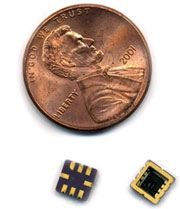Moving towards 3-D micro electromechanical systems
29 Feb 2012
 Microelectromechanical systems, or MEMS, are small devices with huge potential. Typically made of components less than 100 microns in size - the diameter of a human hair - they have been used as tiny biological sensors, accelerometers, gyroscopes and actuators.
Microelectromechanical systems, or MEMS, are small devices with huge potential. Typically made of components less than 100 microns in size - the diameter of a human hair - they have been used as tiny biological sensors, accelerometers, gyroscopes and actuators.
For the most part, existing MEMS devices are two-dimensional, with functional elements engineered on the surface of a chip. It was thought that operating in three dimensions - to detect acceleration, for example - would require complex manufacturing and costly merging of multiple devices in precise orientations.
Now researchers at MIT have come up with a new approach to MEMS design that enables engineers to design 3-D configurations, using existing fabrication processes; with this approach, the researchers built a MEMS device that enables 3-D sensing on a single chip. The silicon device, not much larger than Abraham Lincoln's ear on a U.S. penny, contains microscopic elements about the width of a red blood cell that can be engineered to reach heights of hundreds of microns above the chip's surface.
Fabio Fachin, a postdoc in the Department of Aeronautics and Astronautics, says the device may be outfitted with sensors, placed atop and underneath the chip's minuscule bridges, to detect three-dimensional phenomena such as acceleration. Such a compact accelerometer may be useful in several applications, including autonomous space navigation, where extremely accurate resolution of three-dimensional acceleration fields is key.
''One of the main driving factors in the current MEMS industry is to try to make fully three-dimensional devices on a single chip, which would not only enable real 3-D sensing and actuation, but also yield significant cost benefits,'' Fachin says. ''A MEMS accelerometer could give you very accurate acceleration [measurements] with a very small footprint, which in space is critical.''
Fachin collaborated with Brian Wardle, an associate professor of aeronautics and astronautics at MIT, and Stefan Nikles, a design engineer at MEMSIC, an Andover, Mass., company that develops wireless-sensor technology. The team outlined the principles behind their 3-D approach in a paper accepted for publication in the Journal of Microelectromechanical Systems.






























